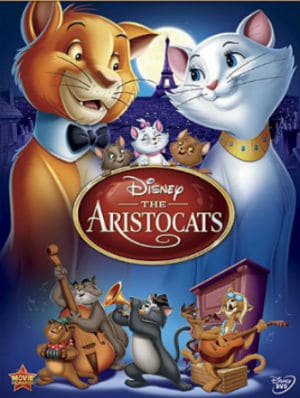
Welcome to Revisiting Disney! Today, we’re looking at that movie which taught us all that everybody wants to be a cat, The AristoCats! Like always, I have labeled each category so if you want to skip to the parts that interest you most, feel free. And, of course, if you have any thoughts, burning or otherwise, please share in the comments!
BACKGROUND OF THE ARISTOCATS
Before Walt Disney’s death in 1966, he had approved the story line for The Aristocats and spent a little time working on The Rescuers (though we’ll talk about that more coming up). The Aristocats, however, was the first Disney Film to be completely made after Walt’s death.
Released on December 24th, 1970, animation historian Christopher Finch calls it a blend of “the vernacular style of 101 Dalmatians with The Jungle Book’s developments in voice characterization,” basically, it looks modern and has strong characters (Finch 1975: 126). He cites those as the reasons that the film is still remembered so fondly today.
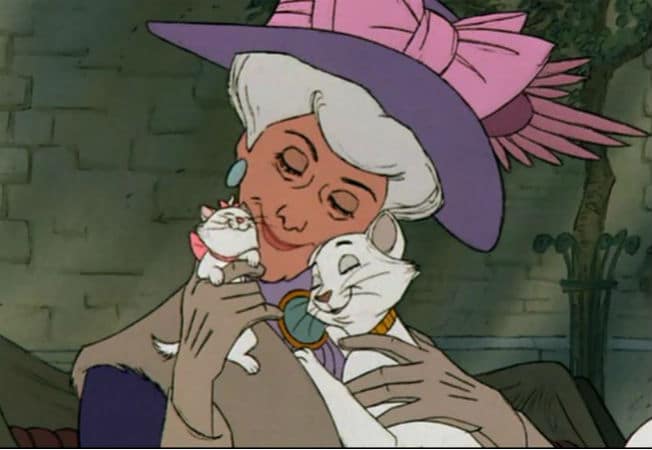
Photo: Disney
Historian Bob Thomas, on the other hand, says that the next few Disney films (The Aristocats and Robin Hood) were “competent films though no trailblazers,” which might be a little unfair, considering how fondly both films are remembered (Thomas 1992:111).
MUSIC
When I thought about The Aristocats as a kid, the first thing that I thought of was the music. Like The Jungle Book, the music was written by the Sherman Brothers, except for one song by Terry Gilkyson and one by Floyd Huddleston and Al Rinker. The score was nominated for a Grammy in 1971 in the category “Best Recording for Children,” and the film won several awards in other countries.
The background music was composed by George Bruns. Like with his other works for Disney, he is again able to weave snippets of the musical numbers into the score. It works wonderfully and ties the whole thing together in a much more cohesive way.
The opening song, The Aristocats, was sung by Maurice Chevalier. According to the Sherman Brothers on one of the special features, they sent him a recording of the song sung by Richard imitating Chevalier. He enjoyed it so much that he came out of retirement to sing the number.
For the song “Everybody Wants to Be a Cat,” the character of Scat Cat was originally supposed to be played by Louis Armstrong. Not only was the music prepared for him, but the character design was based on him as well. Unfortunately, when it came time to record lines and songs, Armstrong was ill and unable to be part of the film. He was replaced by Scatman Crothers, who was told to pretend to be Louis.
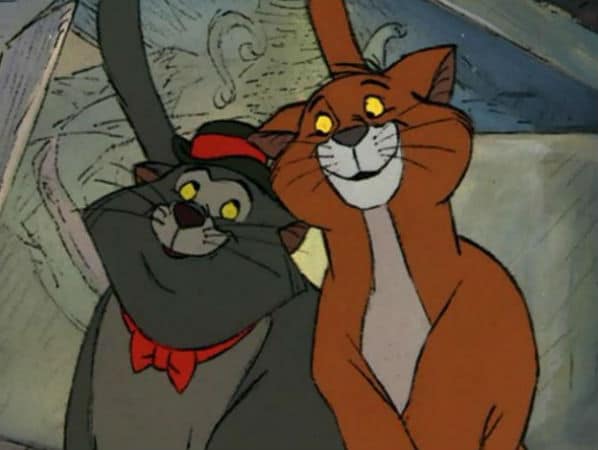
Photo: Disney
There have been some complaints about this number, mostly stemming from the Chinese Cat, who was drawn in a manner very similar to the Siamese Cats in Lady and the Tramp. Some of his lyrics in the song were thought to be pretty offensive, so they were removed from later releases of the soundtrack.
Despite that, the number is jazzy and upbeat, guaranteed to be stuck in your head all day. The other numbers are similar in that they cause extreme toe-tapping, and they might just be stuck in your head all day.
ANIMATION
Some of the Nine Old Men were involved in this film as well. Milt Kahl, Ollie Johnston, Frank Thomas, and John Lounsbery were the directing animators, and Eric Larson worked as a character animator.
Wolfgang Reitherman was a producer (with Winston Hibler) and the director. Ken Anderson, who had worked on several other films (including 101 Dalmatians and The Jungle Book), was in charge of Production Design.
RELATED: Revisiting Disney: 101 Dalmatians
Like with The Jungle Book, the character designs were based on the actors who played them. Phil Harris’s appearance greatly impacted the way O’Malley looked, and Scat Cat was based on Louie Armstrong, who was initially supposed to play him.
The backgrounds have a lot in common with the backgrounds of 101 Dalmatians in that they are very modern and less detailed than the earlier films Disney made; it’s a more modern film overall.
THE PLOT
The story of The Aristocats is different than other Disney films so far. We start out with Madame, a wealthy and eccentric retired actress, living in Paris with her cats, Duchess and the kittens Marie, Berlioz, and Toulouse. She has a wonderful horse and a butler, Edgar, who takes care of the day-to-day work.
First of all, Madame is the most delightful cat lady ever. She’s the kind of cat lady that you would want to be. Madame is totally wrapped up in her cats, but she’s still an elegant lady who takes care of the other members of her household.
There’s a post on Tumblr that points out that Disney could have made her stereotypical and insane a la Madam Mim from The Sword in the Stone, but they made her this graceful and delightful character that you want to be happy because she’s awesome. It’s a really good point, I think.
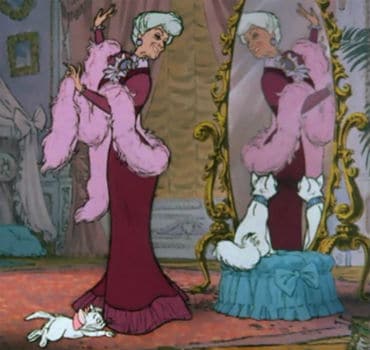
Photo: Disney
Madame has decided to write her will and her butler, Edgar, overhears the conversation. He learns that she is planning to leave her fortune to her cats, and then when they die, the money will go to Edgar. Edgar is shocked that the cats come first and hatches a harebrained scheme to kidnap the cats and abandon them in the country.
There is one major flaw with this scheme, mainly, that even if the cats technically inherit all the money, someone still has to take care of them. That someone would have been Edgar since she already trusts him. He would be the human, so have the fortune in all but name, all he had to do was take care of four cats and keep them at a high standard of living. But not all Disney villains can be clever, I suppose.
Edgar kidnaps the cats and has a run in with two dogs, Lafayette and Napoleon, who chase him and take his hat and umbrella as spoils of war. Over the course of the movie, Edgar has another run in with the two, and though he wins the second battle, it’s some of the funniest animation in the film.
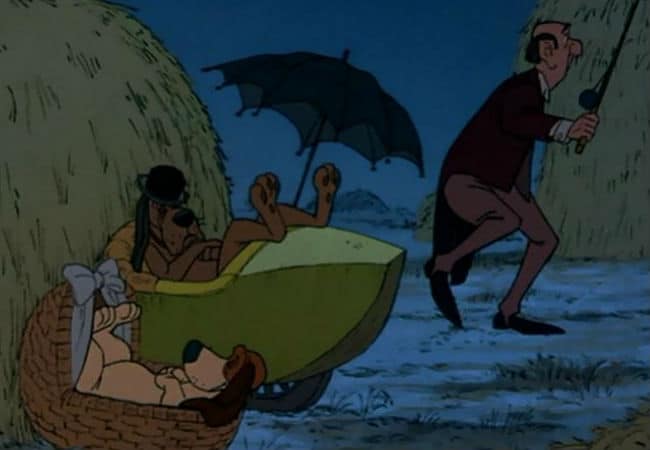
Photo: Disney
Meanwhile, Duchess and the kittens are left alone and scared, unsure how to get back to Paris and Madame. Luckily, they run into Thomas O’Malley, an alley cat who promises to help them get home safely. Of course, along the way they meet some fabulous characters, including some English Geese and Scat Cat and his gang of Alley Cats.
As they travel, Thomas and Duchess fall in love, but she can’t bear the thought of leaving Madame alone. Despite the fact that he really fits in well with the cat family, he brings them home and then leaves, thinking it’s what is best for them. Unfortunately, Edgar is watching and catches Duchess and the kittens.
Fortunately, their mouse friend Roquefort is onto Edgar’s scheme, and he goes after O’Malley, even rounding up Scat Cat and his gang. The alley cats, together with Roquefort and Frou-Frou the horse save Duchess and the kittens while sending Edgar off to Timbuktu.
RELATED: Revisiting Disney: Lady and the Tramp
Madame adopts O’Malley like Tramp was adopted in Lady and the Tramp, and she uses her fortune to set up a foundation that provides homes for all of the alley cats in Paris. The film ends with the animals having a dance party, and we awesome that they all live happily ever after.

Photo: Disney
SOURCE MATERIAL
According to the IMDB, the Aristocats was inspired by true events, in which a family of cats in 1910 Paris inherited a fortune. Disney’s story was based on a story by Tom McGowan and Tom Rowe, and according to sources originally featured a fourth kitten and an additional servant, a maid who was in cahoots with Edgar. Surprisingly, there is not much official information about the original story, but as far as I can tell, the story was simplified to make it less complicated.
The 1970’s
According to historians, the 1970s basically took the issues of the 1960s and continued dealing with them. Marginalized groups continued to struggle for equality, and the protests against the Vietnam War continued, even surging in numbers.
However, at the same time that the movements that started in the late 50’s and picked up speed in the 60’s were increasing in popularity, there was another movement. This counter movement was one that was striving to return not only to the conservative political atmosphere of the 1950s but also to the traditional roles of men and women that were found in the 50’s.
The Watergate Scandal, occurring from 1972 to 1974 with President Nixon’s eventual resignation, left many Americans untrusting of the Federal Government. We’ll touch on this more next week with Robin Hood in 1973, but I did want to mention it here.
The 70’s were the decade of Olivia Newton-John, bellbottoms, and Happy Days, but they were also the decade of Watergate, an increased battle for equality among the citizens of the US, and continuing conflicts abroad. A lighthearted jazzy Disney film like The Aristocats fits the decade beautifully; it distracts from the serious current issues and makes the audience laugh at the same time. It’s perfect entertainment for its day.
LESSONS LEARNED
Personally, I learned that nothing good can come of eavesdropping. Edgar overhears Madame’s’ conversation with Georges, her attorney, and that leads him to kidnap some animals that he had, until that time, seemed fairly fond of. He also betrays the trust of the kind lady who trusts and relies on him and ends up sent to Timbuktu in a truck for his trouble.
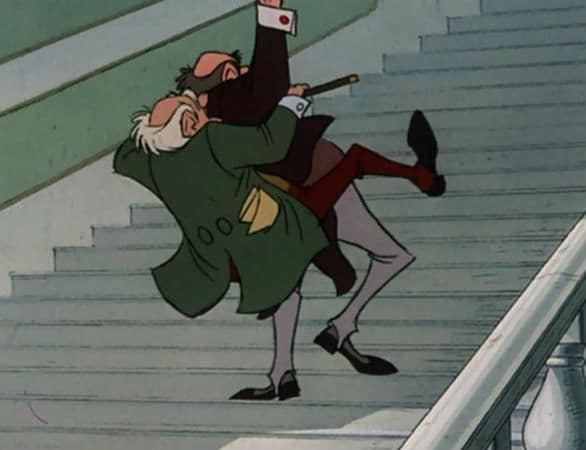
Photo: Disney
Also, manners matter. Even when Edgar is carrying Georges up the stairs on his back because the stubborn old man refuses to ride in the elevator, he’s polite. Duchess teaches her kittens to be polite in all situations, and is polite as well, regardless of how she is feeling. Madame, likewise, is always polite.
Another thing I learned is the importance of practicing daily. Whatever it is that you want to be good at, it’s important to be “faithful to your daily practicing.” This is something that really came across in one of the earlier musical numbers when the kittens are practicing the music and painting skills.
Additionally, the song mentions the importance of starting at the base. To be a good singer or piano player, you have to start with your scales and your arpeggios.
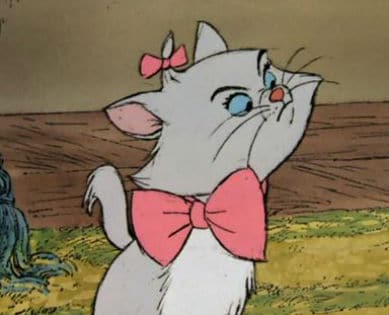
Photo: Disney
Finally, I learned that while ladies do not start fights, they can finish them. Really, this might be one of my favorite quotes in this movie, right up there with “Because I’m a lady, that’s why.” It’s a great response to any question of why you’re doing something (as long as it’s ladylike).
DOES IT HOLD UP?
I have to say that I’d forgotten how funny this movie is. From Uncle Waldo to the most wonderful crazy cat lady ever to the two dogs Napoleon and Lafayette, this movie is full of fun supporting characters. And the main characters are pretty fun too. The use of animals and modern music is fun and makes the film one that is still watched and enjoyed today. At only 78 minutes, The Aristocats is a jazzy, upbeat and fun movie that you can be sure is on the level.
For next week: Robin Hood
If you enjoyed this post and the others in the Revisiting Disney series, and have found yourself wishing that you could find them all in one convenient and bound book with eight extra essays, there is an option for you! Check out A Journey Through Disney: My Look Back Through Disney Canon, now available on Amazon as both a Kindle book ($4.99) and a paperback ($11.99).
OTHER SOURCES:
http://www.history.com/topics/1970s
http://studioservices.go.com/disneystudios/history.html
https://thewaltdisneycompany.com/about-disney/disney-history
Bailey, Adrian. Walt Disney’s World of Fantasy. Everest House Publishers. New York, New York. 1982.
Finch, Christopher. The Art of Walt Disney: From Mickey Mouse to the Magic Kingdom. Harry N. Abrams, Inc. New York, New York. 1975.
Sale, Roger. Fairy Tales and After: From Snow White to E.B. White. Harvard University Press. Cambridge, MA, 1978.
Tatar, Maria. The Annotated Classic Fairy Tales. W.W. Norton and Company. New York and London, 2002.
Thomas, Frank. Disney’s Art of Animation From Mickey Mouse to Hercules. Hyperion. New York, New York. 1992.
Wright, Gordon. The Ordeal of Total War: 1939-1945. Harper Torchbooks, Harper & Row. New York, Hagerstown, San Francisco, and London, 1968.
ARE YOU A ROMANCE FAN? FOLLOW THE SILVER PETTICOAT REVIEW:
 Our romance-themed entertainment site is on a mission to help you find the best period dramas, romance movies, TV shows, and books. Other topics include Jane Austen, Classic Hollywood, TV Couples, Fairy Tales, Romantic Living, Romanticism, and more. We’re damsels not in distress fighting for the all-new optimistic Romantic Revolution. Join us and subscribe. For more information, see our About, Old-Fashioned Romance 101, Modern Romanticism 101, and Romantic Living 101.
Our romance-themed entertainment site is on a mission to help you find the best period dramas, romance movies, TV shows, and books. Other topics include Jane Austen, Classic Hollywood, TV Couples, Fairy Tales, Romantic Living, Romanticism, and more. We’re damsels not in distress fighting for the all-new optimistic Romantic Revolution. Join us and subscribe. For more information, see our About, Old-Fashioned Romance 101, Modern Romanticism 101, and Romantic Living 101.
